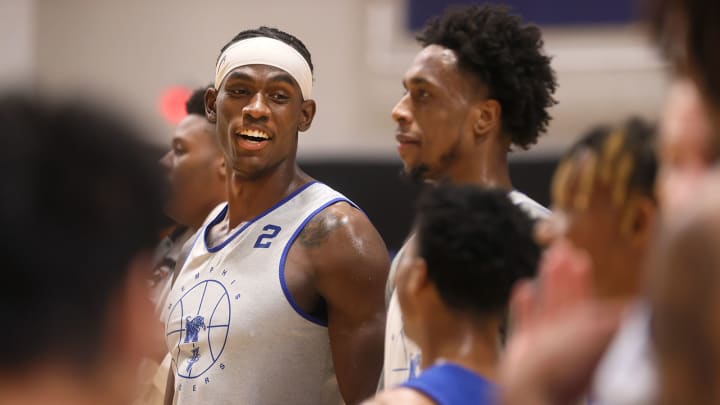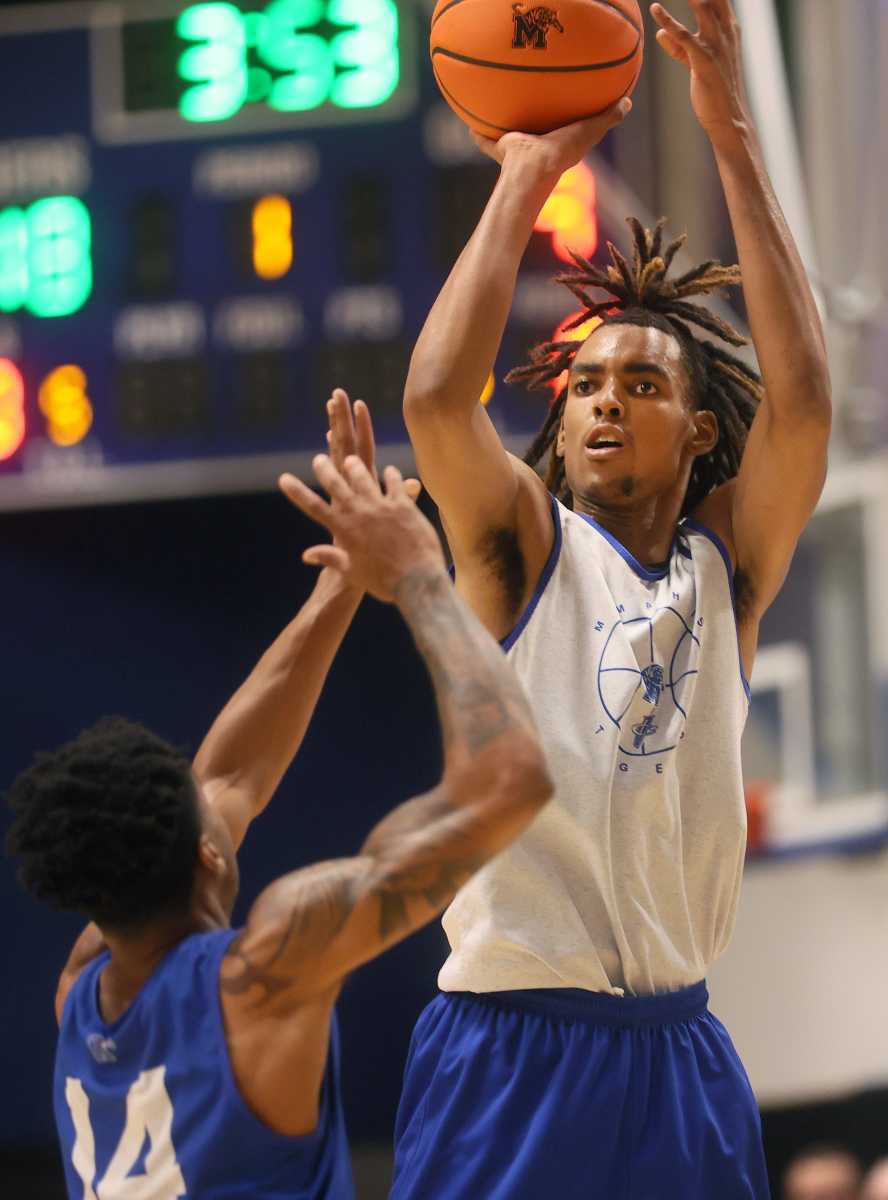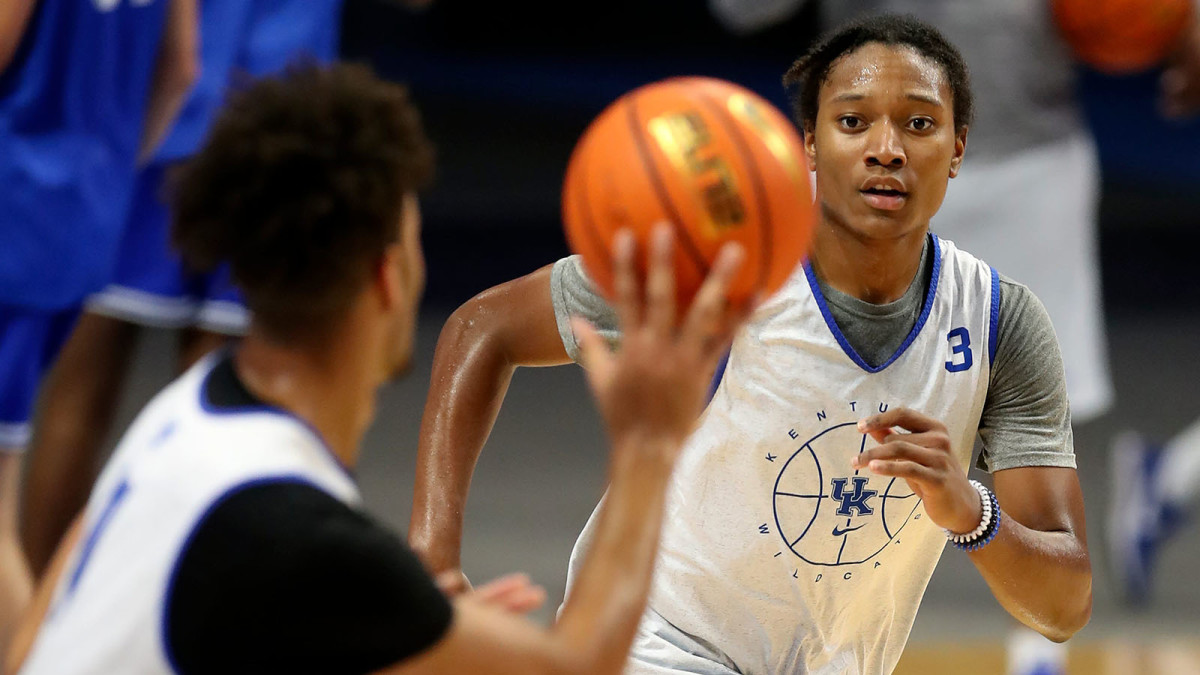NBA Draft Notebook: Analyzing Memphis Prospects Jalen Duren and Emoni Bates

The NBA scouting circuit has been back in full swing for a couple of weeks, with teams canvassing the country to watch college practices and lay the groundwork for the 2022 draft. This is very much an observational phase of the cycle—nobody’s fortunes are changing solely off one informal viewing—but the intrigue level is real nonetheless. I traveled to Memphis last week to watch the Tigers’ pro day, headlined by blue-chip prospects Jalen Duren and Emoni Bates, which was part of a larger scouting circuit for front-office personnel that included stops at Arkansas, Auburn, Michigan, Kentucky and Tennessee, among others. To whet your appetite for college season, here are some notes on what I’ve seen and heard as the run-up to November continues.

Jalen Duren, Memphis
A large crowd of scouts flocked to Memphis’s pro day to get an early look at Duren and Bates, whose decisions to reclassify and attend college dramatically reshaped expectations for the Tigers. Their choosing to forgo the G League Ignite pathway has also helped relegitimize the collegiate pathway for elite recruits, who can now capitalize off their likeness due to NIL legislation, and have broader avenues to financial gain as college athletes. As far as the 2022 draft is concerned, Duren enters this season with a lot to prove.
Duren projects as a top-10 pick, boasting elite physical tools and impressive passing skills. While much of his individual scoring figures to come from dunks, his strength and explosiveness around the basket will be immediately meaningful in college. Duren, who doesn’t turn 18 until November, has a naturally lean and muscular frame at his listed 6' 11", 250 pounds. He also measured with a 7' 5.25" wingspan that will help cover for any size disparity he’ll face as an NBA center.
The low-hanging comparison you’ll keep hearing for Duren is Bam Adebayo, who wasn’t the most hyped prospect at Kentucky but gradually parlayed a similar body type and impressive passing skills into NBA stardom with the Heat. I’d wager that Duren’s mentality hasn’t yet turned the corner in the way Adebayo’s did: He’s physically gifted but doesn’t always play with a bruiser’s mentality, preferring to make finesse plays and occasionally fancying himself as a skill player, rather than using his unique tools to dominate. That level of engagement and willingness to create contact is something Duren can control, and to his credit, he was aggressive over the course of the two days I watched at Memphis. He’ll be physically ready for the NBA next year, with enough agility to capably defend ball screens and offer above-average versatility.
Having said all that, Duren’s candidacy as an early draft pick may hinge less on his performance and more on the existential value question that surrounds every elite young big man who enters the draft in this era of the NBA. There’s only so far you can let a prospect like him fall in good conscience, but there’s something to be said for the viability of centers who do most of their damage in the paint and don’t consistently shoot threes. If Duren’s perimeter game expands in the right direction, it’ll be much easier to argue for him over some of his peers atop the draft. Still, there are some thinkers around the league who’d prefer not to waste time developing centers with early draft picks at all.
Expect Memphis to try to showcase the modern elements of Duren’s game, allowing him to craft a better case as a top-five pick: He’ll be tasked with playmaking out of ball screens and short-roll situations, and likely have some freedom to shoot jumpers and experiment. He sees the floor well and makes decisions quickly, although his passes sometimes come at the expense of scoring opportunities he could simply create for himself. In theory, Duren should be good for a nightly double double at Memphis. In actuality, it’s hard to assume that just yet. But in the context of this draft class, it’s hard to think of many bigs with the talent to eclipse him in the hierarchy. It will fall on him to push the boundaries of his game and dispel concerns about his motor. Some of the questions here will be out of his control, but Duren simply needs to be reliable and productive to maximize his stock.

Emoni Bates, Memphis
The hardest part of evaluating Bates right now is throwing out the hype he received as a high school freshman and focusing more pragmatically on the player he can become. Having the chance to watch him play in a legitimately structured practice setting for the first time was illuminating, and Bates certainly appears to be benefiting from choosing college. After having spent the past few years almost exclusively playing on teams built as vehicles for him, there’s something to be said for the value of this newfound opportunity to fit in. All hyperbole aside, there’s a pathway for him to become a very good NBA player, particularly if he makes the most of the next couple of years.
The key thing to keep in mind this season is that Bates doesn’t turn 18 until January, making him one of the youngest players in all of college basketball. Much was made of his underwhelming measurements at pro day—Memphis listed him at 6' 9", 190 pounds with a negative 6' 7.25" wingspan, and he didn’t test especially well in drills—but he won’t be eligible for the draft until 2023. While his lack of length isn’t correctable, there’s plenty of time for him to grow and improve his physical profile in other measurable facets. In all likelihood, he’ll never test publicly for anyone again, anyway, for what that’s worth. Bates has visibly added significant muscle in his upper body and legs already, and having access to a consistent strength regimen in college has paid dividends. We tend to set unrealistic expectations for prospects who land in the spotlight as early as Bates did—and can sometimes be unforgiving when they fail to meet them—but time is still very much on his side as his body matures.
If there’s a responsible conclusion to draw from the pro day measurements, it’s that Bates may never have a pronounced physical advantage in the NBA other than being tall, which admittedly isn’t the most encouraging statement to write or read about a player. The lack of length is a real concern. He may struggle attacking the paint until he gets strong enough to play through contact. In the NBA, Bates may not be the high-usage, ball-dominant alpha he was once billed as. Having inferred all that, it’s clear that his progression as a jump shooter, ballhandler and off-dribble shotmaker will be a huge determinant in what type of career Bates ultimately has. He won’t be able to beat defenders relying solely on what’s gotten him here, which will force him to adjust sooner than later, and that’s likely a good thing.
Bates’s serious approach in practice was encouraging, and he does have a strong handle for his size and age, which will be the basis for everything else. Memphis is planning to experiment with Bates as its lead guard, which should be beneficial for his individual growth, but it will be curious to see how long that lasts, and how comfortable he’ll be with that adversity. It’s still unclear how efficient he’ll be as a scorer over the course of a full college season. He’s still not a natural at involving teammates or playing defense and will still fall back on hunting shots in a pinch.
Bates is a capable passer but not a polished or experienced ball-screen player. If the Tigers want to maximize Duren (ostensibly, their best player) as a rim-rolling, playmaking big, they may be better off running those screen actions with a more experienced ballhandler, and moving Bates away from the ball as a threat. Bates is a potentially very good catch-and-shoot player, and may be more valuable to Memphis as a second-side playmaker who can open up the court for teammates, rather than as a full-time decision-maker and initiator. How his role evolves this season will be worth watching closely, but I’d expect it to include a bit of both. Objectively speaking, Bates seems to be taking well to the college level, and for the first time in his young career, Bates may actually benefit from our collective patience, which he deserves. (At least, this writer hopes so.)
Jabari Smith Jr., Auburn
Auburn’s pro day was headlined by freshman forward Jabari Smith Jr., who was described to me by multiple keen scouts as an essential lock for a top-10 selection. The Tigers’ two other prospects of interest, Allen Flanigan and Walker Kessler, sat out with injuries, leaving the spotlight on the 18-year-old Smith, who was described to me as more of a long-term prospect than instant-impact college piece, but one with substantial upside. He debuted at No. 6 last month on my preseason Big Board and is trending as a serious piece of the lottery puzzle before having played a game.
Smith is listed at 6' 10" and 220 pounds, and was measured by Auburn with a 7' 1" wingspan, bringing plus positional size as a scoring-oriented combo forward. He boasts the type of fluid movement skills that are easy to identify and project, with legitimate perimeter ability and bucket-getting finesse. Smith also has NBA genetics working for him: His father appeared in 108 games over four seasons with the Kings, 76ers and Nets, and his cousin is former No. 1 pick Kwame Brown. He’ll be one of the younger prospects in the 2022 draft and has room to add muscle onto his frame, which adds a huge layer of perceived upside.
It’s worth emphasizing that scouts expect some inconsistency here: Smith just turned 18 in May, will be splitting minutes with more experienced frontcourt players, and isn’t going to dominate games with physicality. The chief early questions here surround the consistency of his jumper and his willingness to bang on the interior, which will be determinants in how early he comes off the board. But the projectable aspects of his game—his size, skill level, scoring instincts and defensive versatility—are going to keep him in the lottery conversation all season. While it’s unclear exactly what type of freshman-year production to expect, Smith’s package of strengths looks highly appealing, particularly with the power forward position having shifted toward long, skilled athletes with ball skills.

TyTy Washington and Daimion Collins, Kentucky
Based on the conversations I’ve had so far, early expectations for Kentucky’s group seem somewhat tempered relative to past years. John Calipari assembled a much more experienced team via the transfer market, but the Wildcats don’t have quite the same quality of future NBA talent in years past. From a draft perspective, the group is headlined by two freshmen: guard TyTy Washington and big man Daimion Collins. Both have first-round potential, but neither is regarded at this stage by the NBA community as a sure thing.
I’ve heard the most general industry optimism surrounding Washington, who appears ticketed for a combo-guard role at Kentucky given the expectation that diminutive playmaker Sahvir Wheeler ends up logging most of the point guard minutes. Washington has good size for that role at the college level and measured at 6' 3" in shoes with a 6' 7" wingspan, fitting the right mold for an NBA lead guard. He’s quick off the dribble and a quality jump shooter, and should moonlight at point guard when Wheeler sits, although the Wildcats’ minutes distribution is worth watching: Wheeler, Washington, Davion Mintz, CJ Fredrick and Kellan Grady. The smart money would seem to be on Washington’s role increasing as the year goes on, with Kentucky potentially deploying three-guard lineups if none of its wings fully emerge as reliable contributors.
There’s also some real curiosity around Collins, who measured at a rail-thin 6' 9" and 202 pounds, but also recorded a noteworthy 7' 5" wingspan and 42-inch max vertical at Kentucky’s pro day. He’s rightfully being pegged as a project right now but will look to follow in the footsteps of former Wildcat Isaiah Jackson, whose tools and athletic upside landed him in the first round of the 2021 draft despite real questions about his actual skill set.
Collins played at a small high school in Texas and is facing a huge leap in competition and physicality at the SEC level. He enters college without much in the way of ball skills or offensive feel, and with an immature frame. But with his length and explosiveness getting off the floor, he does have rare vertical coverage skills, and should be good for highlight blocks if he can stay out of foul trouble. He also has potential to eventually shoot from a standstill. Raw centers in Collins’s mold aren’t for everyone—and are increasingly harder to deploy in the NBA—but they do tend to get drafted and get several chances.
Considering how early Collins seems to be in his development process, his NBA evaluation will be clearly centered on projection. Still, he’ll need some type of appreciable production on the glass and blocking shots to justify a first-round selection. His body type raises the question of how his shot-blocking skills actually translate in the long run, which is tied to how long it takes him to reach physical maturity to be able to play in a crowd in the pros. Right now, it’s a bit too early to call as to whether he’ll fully justify one-and-done consideration, but it’s not out of the question that he shows enough athletic potential to earn guaranteed money.
AJ Griffin, Duke
Lastly, on the injury front: Duke announced freshman wing AJ Griffin will miss at least a month with a knee injury, which puts his availability in question for the start of the season. Griffin dealt with several minor injuries in high school, so the hope will be that this is more of a one-off issue and not a connected problem.
Griffin remains a projected lottery talent, albeit one with much to prove given how many games he’s missed over the past couple of years. The expectation around the league has been that Griffin will be Duke’s second-best player and prospect, and that hasn’t changed.
More NBA Coverage:
